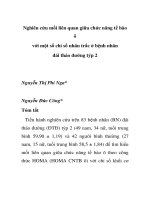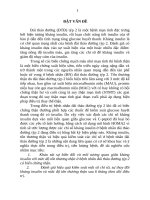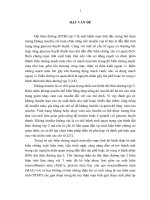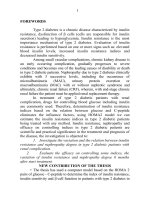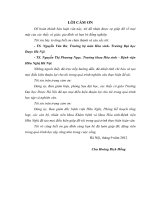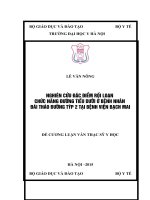Nghiên cứu kháng insulin, chức năng tế bào tụy alpha, bêta ở bệnh nhân đái tháo đường týp 2 được điều trị bổ sung thuốc ức chế enzyme DPP 4 tại bệnh viện nội tiết trung ương tt tiếng anh
Bạn đang xem bản rút gọn của tài liệu. Xem và tải ngay bản đầy đủ của tài liệu tại đây (316.06 KB, 32 trang )
1
PREFACE
Diabetes is a group of metabolic diseases, characterized by
chronic hyperglycemia due to deficiency in insulin secretion,
defective effect of insulin or a combination of both. Chronic
hyperglycemia of diabetes causes long-term harm, dysfunction and
multiple organ failure, particularly eye, kidney, nervous, cardiac and
vascular diseases.
The declination of beta-cell function and insulin resistance
are the main mechanisms of type 2 diabetes. The role of insulin
resistance or beta-cell dysfunction in each patient is variable.
Through the effects of endogenous incretin, DPP4 inhibitors
stimulate beta-cell growth, insulin secretion and glucose-dependent
glucose-dependent glucose blockers, DPP4 inhibitors in the secondline drug recommendation for Met, when Met mono-therapy failed to
achieve KSGM goal.
The DPP-4i group has not been studied extensively in Vietnam.
Conducting the study: Research on insulin resistance, pancreatic
alpha and beta cell function in patients with type 2 diabetes mellitus
treated
with
suppressive
DPP-4i
therapy
at
the
National
Endocrinology Hospital with two goals:
1. Determination of insulin resistance, alpha and beta pancreatic
cell function and its theirs association with some parameters
in patients with type 2 diabetes mellitus.
2. Evaluation of blood glucose control and alteration of insulin
resistance, pancreatic alpha and beta-cell function after
supplementation with DPP-4i in patients with type 2 diabetes
who are taking other diabetes oral medications.
Scientific significance
2
This study showed that when supplemented with sitagliptin,
patients treated with diabetes with other pills oral medications
improved blood glucose, improved insulin resistance, improved betacell function and glucagon concentration, and showed the role of
glucagon in the variation in blood glucose including the pathogenesis
of diabetes.
Practical significance
Determining tThe results of blood glucose control and alteration
of insulin resistance, pancreatic alpha and beta-cell function after
supplementation with DPP-4i in patients with type 2 diabetes
mellitus treated with other blood and some related factors.
New contributions of the thesis
CFollowing combination therapy with DPP-4i, type 2 diabetes
mellitus patients who were receiving other glucose lowering drugs
had reduced FPG, PPG2h, HbA1C and altered insulin resistance
index, fasting plasma C peptide, beta -betaine phosphate, fasting
plasma glucagon and the role of glucagon in blood sugar variability
The composition of the thesis
The dissertation is 127 pages (excluding the annexes and
references), which consists of 6 parts: preface (2 pages), overview
(34 pages), subjects and methods (19 pages), research (32 pages),
discussion (38 pages), conclusions (2 pages), and recommendations
(1 page). The thesis has 6 appendices, 40 tables, 19 charts and 132
references, of which 28 in Vietnamese and 104 in English.
3
CHAPTER 1: OVERVIEW OF DOCUMENTS
1.1. Diagnosis criteria and mechanism of diabetes mellitus
1.1.1.
Diagnostic criteria for diabetes mellitus
According to the Diabetes Association of America in 2015: based on
one of four criteria:
a) Blood glucose (venous blood) ≥ 126 mg / dl (7mmol/l) (after
8 hours intolerance) (measured 2 different times different)
b) Any blood glucose level ≥ 200mg / dl (11.1mmol/l) and signs
of hyperglycaemia (excessive drinking, frequent urination,
unresolved weight loss)
c) Blood
glucose
(glucose
tolerance
test)≥200mg/dl
(11.1mmol/l) after 2 hours oral 75g glucose (glucose
tolerance test)
d) HbA1C ≥6.5%, performed in a laboratory-tested, calibrated
and normalized manner .
1.1.2.
Mechanism of pathogenesis of type 2 diabetes mellitus
Beta-cell function and insulin resistance are the main
mechanisms of type 2 diabetes. At present, at least eight factors
contribute to hyper-glycaemia.
1.2. Insulin resistance and beta-cell function decline, glucagon
secretion disorders and incretin related defects in diabetes
mellitus
1.2.1.
Insulin resistance in patients with type 2 diabetes mellitus
Insulin resistance is a decrease in the biological effects of insulin.
Characteristics of type 2 diabetes: insulin resistance and known
major motor insulin resistance, hepatotoxic and fatty insulin
resistance.
4
Main mechanism of insulin resistance: Deficiency of insulin or
receptor signaling pathways in type 2 diabetes
Insulin resistance factors: related to genetic factors, acquired
factors, overweight obesity and decreased physical activity
1.2.2.
Decreased beta cell function
Causes: Genetic and environmental effects, effects of fetal and
adolescent development, hyper-glycaemia, "Lipotoxicity".
1.2.3. Methods for evaluating insulin resistance, beta-cell function
There are many different methods of assessing insulin
sensitivity / resistance with different strengths and weaknesses.
HOMA: evaluation method of homeostasis equation, assessment of
correlation between G and I in the steady state
* Model Homa 2 (Assessment of the equilibrium model of
homeostasis 2) Computer method, HOMA 2 is a model of
transmission.
- HOMA2 calculate accurately
- HOMA 2 is an experimental model used for non-specific insulin
and insulin-specific insulin; used for C-peptide replacement for
insulin; Taking into account the fact that glucose tolerance in the liver
and muscles, it can be used even if blood glucose > 10 mmol/l.
1.2.4. Physiological and abnormal glucagon roles in type 2 diabetes
Physiological role of glucagon: increases blood glucose levels
through increased glucose production in the liver
Regulation of glucose secretion: Glucagon secretion by regulating
blood glucose levels in contrast to the effect of blood glucose on
insulin secretion.
Glucose Disorder in Type 2 Diabetes: Glucagon increased in both
postprandial and postprandial conditions, leading to hyperglycemia
5
Other methods of evaluating alpha cell function: Up to now there
have been noare not many studies and there is no standardized
method for the widespread use of alpha-cell function assessments in
type 2 diabetes.
1.3. Treatment of type 2 diabetes
*Treatment goal: according to recommends current ADA 2015
treatment goals.
*Drug therapy: Most patients with type 2 diabetes mellitus are
required to achieve optimal glycemic control.
*Dipeptidyl Peptidase-4 (DPP-4) Inhibitor: acts to prevent the
breakdown of the protein of the endogenous incretin molecule,
prolonging the activity of the endogenous incretin molecule.
*Sitagliptin: The mechanism of action of the drug sitagliptin is to
inhibits the breakdown of GLP-1 by inhibiting the enzyme that
disrupts GLP-1. Sitagliptin increases the endogenous GLP-1 effect by
prolonging the survival time of this hormone.
+ Dose: Sitagliptin fFor type 2 diabetes mellitus with normal renal
function, sitagliptin is given at 100 mg / day of monotherapy, or in
combination with Met, thiazolidinedione, SU or Met combined with
SU
- There are also saxagliptin, alogliptin, vildagliptin
* ADA guidelines from 2012 up to date DPP-4i have been added as a
third drug and a fourth drug when HbA1C did not reach its goal after
3 months.
1.4. A number of sStudies on endocrine pancreatic function and
use of DPP-4i in type 2 diabetic patients
6
1.4.1.
International studdyy on the efficacy of DPP-4i for blood
glucose control, insulin resistance, beta-cell function, and plasma
glucagon concentration
In 2006, in the study of Charbonnels B and CS, after adding 100 mg
sitagliptin, the A1C decreased 0.67% than the original A1C, the
average blood glucose decreased 0.9 mmol/l compared to the initial
fasting blood glucose level. C-peptide increased from 0.83 nmol / l to
0.93 nmol/l, HOMA-B increased from 46.4% to 65.2%.
1.4.2.
Domestic study of insulin resistance, alpha cell function
alpha cell function, beta cell function in type 2 diabetic patients
In the year 2012, Nguyen Thi Thu Thao noted: Rate of insulin
resistance: HOMA2-IR-Cp 84.7%; Beta-cell function decline:
HOMA2-% B-Cp was 76.9%. Recognition of pathogenesis including
insulin resistance and beta-cell function decline (C-peptide 84.7%
insulin resistance, 76.9% reduction in beta-cell function).
7
CHAPTER 2
OBJECTIVES AND RESEARCH METHODS
2.1. Research subjects
Subjects: 166 people devided into 2 groupConsisted of 166 people
(screening on 300 subjects), obtained 101+ Group 1: : 65 healthy
subjects
+ Group 2: and 101 patients with type 2 diabetesdiabetes. These
patients were treated with oral hypoglycemic agents other than DPP4 enzyme inhibitor with a stable dose for 3 months but has not yet
achieved the goal of blood glucose control.. Prior study 3 months of
treatment with oral hypoglycemic drug, after 3 months have not
achieved the target of cyanosis are included in the study.
2.1.1. Subject Selection Criteria Standard selection object
2.1.1.1. Criteria for selection of patients with type 2 diabetes
+ Type 2 diabetes patients diagnosed according to ADA
2015 standards based on 1 of the following 4 criteria:
1) Fasting blood sugar (venipuncture) ≥ 126 mg / dl (7mmol /
l) (after 8 hours of calorie intolerance) (measured twice
differently)
2) Any blood sugar ≥ 200mg / dl (11.1mmol / l) and
manifestations of hyperglycemia (heavy drinking, excessive
urination, unexplained weight loss)
3) Blood sugar after 2 hours of taking 75g glucose (glucose
tolerance test) ≥ 200mg / dl (11.1mmol / l)
4) HbA1C ≥ 6.5%, performed at the correct laboratory and
standardized method
8
In the absence of clinical symptoms of hyperglycemia and a
markedly low blood glucose level, one of the four criteria should be
repeated on another day to confirm the diagnosis.
+ HbA1C from 7.0% to ≤ 10% and GML from 7
mmol / l to ≤ 16 mmol / l
+ From 30 years or older; Agree to join NC
+
Patients Type 2 diabetic patients who were treated for diabetes
mellitus by oral hypoglycaemic or combination non-DPP-4
combination therapy were given stable doses over 3 months and
failed to achieve glycemic control.
+ The standard has not met the target based on GM from 7
mmol /l to ≤ 16 mmol / l and has HbA1C from 7.0% to ≤ 10%.
+ No anemia; age of 30 years or above; Agree to participate
in research
2.1.1.2. Criteria for selecting control subjects
+ Over 30 years old.
+ Currently identified as healthy people based on histry, physical
examination and basic biochemical tess
+ No risk factors; FPG, HbA1C normal
+ Agree to participate in research.
2.1.2. Exclusion criteria
2.1.2.1. Group of patients with type 2 diabetes
+ Patients with a history of erythrocyte anemia have been identified,
hemolytic anemia (female hemoglobin <120 g / l and male <130 g /
l), the test has abnormal stimulation of red blood cells and can
Hemoglobin hemoglobin.
+ Liver enzymes increase ≥ 3 times the high value of normal.
9
+ Being suffering from other acute diseases that require
hospitalization.
+ Patients with unstable angina, myocardial infarction, cerebral
vascular accident, coagulopathy, severe exhaustion, mental disorders.
+ Type 2 diabetic patients being treated with DPP4 inhibitors and
GLP1 receptor agonists.
+ Do not use thyroid hormone drugs
+ Do not have thyroid disease
+ Do not collect enough study information
+ Do not agree to participate in research.Group 2 diabetic patients
+ Have glomerular filtration rate <45 ml/min
+ Liver enzyme increased ≥ 3 times the high
value of normal.
+
Being
admitted
to
other
acute
care
hospitals.
+Patients
with
unstable
infarction,
angina,
myocardial
cerebrovascular
coagulopathy,
severe
accident,
exacerbation,
mental
disorders.
+
Patients
treated
with
with
type
DPP4
2
diabetes
inhibitors
and
are
/or
being
GLP1
receptor agonists.
+ Do not use thyroid hormone
+ There is no thyroid disease
+
Patients
do
not
indicators
2.1.2.2. Healthy controls group
collect
enough
research
10
In history or at present there are chronic diseases, especially
cardiovascular and metabolic diseases: hypertension, type 2
diabetes (based on basic biochemical tests).
+ Pregnant women.
+ Are suffering from acute infections.
+ Have been taking or have taken some medicines in the last 3
months such as corticosteroids, birth control pills.
2.1.3. Time and place of study
- Study Period: April 2014 to February 2017.
-Location:
Outpatient
Department,
Central
Hospital
of
Endocrinology.
2.2. Research Methods
2.2.1. Sampling: Random, convenient.
2.2.2. Study design: Describe, evaluate and intervene before and
after intervene
2.2.3. Determining the sample size:
Replacing the values for we have the sample size: n = 78, in fact, the
sample size is 101surpassed 101.
2.2.4. Research content (Diagram 2.1)
2.2.4.1 For patients with type 2 diabetes mellitus
- Patients were evaluated clinically and subclinically at baseline and
12, 24 weeks after DPP4i combination:
- Clinical indicators
- Subclinical indicators: fasting plasma glucose, 2-hour postprandial
blood glucose, HbA1C, fasting plasma C-peptide (nmol / l),
calculation of HOMA2 indices.
- Fasting Glucagon in 30 patients randomly selected in each group.
11
- Urea (mmol/l), creatinine (µmol/l), SGOT, SGPT fasting plasma
- Cholesterol TP, Triglyceride, HDL-C, LDL-C in fasting plasma.
+ Drug treatment
* The oral hypoglycemic drugs that patients used before the study
were continued to be used and kept the same dose throughout the
study including: metformin and gliclazide
* All patients were given DPP-4i: an initial dose of 50 mg or 100 mg
Sitagliptin daily during the first 12 weeks. After 12 weeks, the dose
was adjusted to suit each patient: if HbA1C <7.5% and currenly
taking the dose of 50mg/day, then increase sitagliptin dose to
100mg/day during the next 12 weeks. If HbA1C <6.5%, and
currently taking a dose of 100mg/day, reduce the dose to 50mg/day
during the next 12 weeks.
Evaluation of patients is done twice: after 12 weeks - 24 weeks
Evaluation of clinical and subclinical indicators according to a
uniform medical record: - Height, weight, BMI calculation, BP
measurement and heart rate.
- Subclinical: GMLA, GMSA2h, urea, creatinine, SGOT, SGPT,
Cholesterol, Triglyceride, HDL-C, LDL-C, C-peptide, serum
glucagon at fasting (only at 12 weeks in 30 patients).
- Monitor side effects: Headache,
urticaria,
sinusitis;
rhinitis,
stomachache.....Control
group:
- Patients were asked for clinical and subclinical exams to collect the
research indicators in the form (Appendix 4).
- Test of blood glucose: FPG (mmol/l), PPG2h (mmol/l), urea
(mmol
/l),creatinine(μmol/l),SGOT(u/l),SGPT(u/l).
12
.Triglyceride
(mmol/l),
HDL-C
(mmol/l),
LDL-C
(mmol/l)
. Fast plasma plasma C-peptide assay (nmol /l).
+ Serum glucose serum indices (T0) and after 12 weeks (T3) in 30
patients after combination therapy with DPP-4i
+ Drug treatment
* Blood pressure medications used by patients prior to study were
continued and remained unchanged throughout the study period: Met
and gliclazide.
* All patients were given DPP-4i: Sitagliptin suit each patient,
individualize treatment. 101 patients with type 2 diabetes mellitus
who in a median follow-up of 24 consecutive weeks, to meet ADA
2015 target without causing hypoglycemia.
Patients monitoring method in 12-24 weeks
These patients were the test is done on a sample. Patients are guided
proper diet and exercise and use of hypoglycemic drugs. Guide
patients to check PPG 2h at home.
2.2.4.2 Control group: The clinical and subclinical examinations
collect the standardized research indicators (Appendix 4) as for the
sickthe same way as the sick group
. Fasting plasma glucagon was measured in 30 patients at baseline
(healthy controls)
- Assessment of insulin resistance, beta-cell function: The insulin
resistance was defined by HOMA2-IR-CP. It is caculated by fasting
plasma glucose levels and fasting plasma C-peptide levels.
- C-peptide plasma: considered normal within ± SD, increased when
> + SD and decreased when <- SD value of NC
13
- Diagnosis of insulin resistance: Based on the HOMA2-IR index, the
quartile cut-off value in HOMA2-IR index of control group was
calculated following the WHO recommendation in 1999.
- Diagnosis of beta-cell function reduction: based on HOMA2-% B,
cut-off point < - SD value of control group
- Diagnosis of alpha-cell function: based on glucagon concentration,
cut-off point >+ SD value of control group
2.2.2.3: Research diagnostic, assessment and classification criteria
- Diagnostic criteria of diabetes mellitus: ADA 2015
- Assessment criteria for FPG and PPG 2h control: HbA1c: ADA
2015
- Classification criteria for Body Mass Index (BMI): Based on BMI
of the Vietnamese Association of Diabetes and Endocrinology
Guideline in 2016
- Classification criteria for dyslipidemia: in 2016 of the Vietnamese
Association of Diabetes and Endocrinology guideline, in 2016.
- Classification criteria for hypertension: Ministry of Health (2010).
2.2.2.4: Data processing: Using SPSS software 22.0.
2.3 Trial design
Patients enrolled
(n=166)
Healthy controls
(n= 65)
Screening
Patients with T2DM
using hypoglycemic
medications ( n= 101)
Insulin resistance,
Insulin resistance,
Alpha-cell function, Alpha-cell function,
beta-cell function
beta-cell function
Screening
Compare
Insulin resistance, Alpha-cell Glucose
Changes in insulin
control
function and Beta-cell function
resistance, alpha-cell
Conclusion
1
Request
status in
Patients with T2DM
function
and beta-cell
After
Conclusion
3 months,
2 6 months
function before and
14
CHAPTER 3
STUDY RESULT
3.1: General characteristics of the study subjects
3.1.1: Gender, age , BMI and Diabetes detection time
Table 3.1, 3.2, 3.3 Gender, age and Diabetes detection timeBMI in
control group and treatment group
- The ratio of male and female in 2 groups is not statistically
significant.
- Age average 54,13 ± 10,11 (years).
- The Diabetes diagnosis time less than 5 years had the highest
rate (83.1%). Diabetes diagnosis time over 10 years is the lowest
(5%).
- BMI in the treatmet group is 23.49 kg/m2, which is higher than
control group of 21.53 kg/m2. The proportion of overweight and
obesity patients higher than normal.
3.1.2 Subclinical characteristics
Table 3.4 Baseline Plasma glucose index FPG , PPG 2h, HbA1C
sequence 8,62 ± 1,67 (mmol/l); 12,36 ± 2,36 (mmol/l); 7,93 ±
0,83(%)
Table 3.5 Proportion of baseline patients who meet and do not
meet blood glucose target
Only a few patients achieved FPG, PPG 2h was 18.8%, 11.9%
All patients failed to achieve HbA1C goal at baseline.
3.1.3 Pre-study Anti-diabetes drugs characteristics
Table 3.6: Pre-study anti-diabetes drugs
15
Anti-diabetes drugs
Number
Proportion (%)
(n)
Met (mg)
61
60,4
SU Met (mg)
40
39,6
Before the study, all patients had only oral anti-diabetes drugs
3.2 Insulin resistance, pancreatic alpha-cell and beta-cell
function in Patients with T2DM
3.2.1 Insulin resistance Index in Patients with T2DM
Table 3.7 HOMA2-IR comparison
Control
Treatmen
Index
group
t group
p
(n=65)
(n=101)
± SD
1,34 ± 0,34
3,03 ± 0,97 < 0,001*
HOMA2 Limit index
-IR-Cp
(quartile251,05 – 1,650
75)
Not increase
48 (72,2%)
9 (8,9%)
<0,001**
(<1,650)
Increase
17 (26,2%)
92 (91,1%) <0,001**
(>1,650)
* Independent – Samples T-test accrediation; ** χ2 accrediation ;
Treament group had a lower non-insulin resistance proportion
than control group. Treatment group have higher rates of insulin
resistance (91,1%) than control group (26,2%)
3.2.2 Beta-cell function in Patients with T2DM
Table 3.8 HOMA2-%B-CP comparision
Index
( ± SD)
Control group
(n=65)
112,82 ± 28,34
Treatment
group
p
(n=101)
73,51
± < 0,001*
25,14
16
HOMA2- (- SD)
%B
Cp Decrease
(%)
(<84,48)
84,48
10 (25,4%)
62 (61,4%)
<0,001*
Not
Decrease
55 (84,6%)
39 (38,6%)
<0,001*
(≥ 84,48)
* Independent – Samples T-test accrediation; ** χ2 accrediation ;
The reduction in HOMA2-% B in treatment group is higher than
in the control group
3.2.3 Alpha-cell function in Patient with T2DM
Table 3.9 Fasting plasma glucagon concentration comparison
Index
Glucago
n
(Pg/ml)
( ± SD)
Limit Index
- SD)
Decrease
(< 29,88)
Normal
(29,88-38,70)
Increase
(> 38,70)
Control
group
(n=30)
Treatment
group
(n=30)
34,29 ± 4,41
70,86 ± 12,73
p
< 0,001*
29,88
4 (13,3%)
0 (0%)
22 (73,3%)
0 (0%)
4 (13,3%)
30
(100,0%)
< 0,001**
* Independent – Samples T-test accrediation; ** χ2 accrediation
Figure 3.2, 3.3, 3.4, 3.5: Correlation between glucagon and
FPG, PPG2h, HbA1C, HOMA2-%B-Cp in patients at baseline
with no combination of DPP4-inhibitors (n=300).
Fasting plasma glucagon concentration at baseline without DPP4inhibitor
combination
correlates
posotively,
strictly
and
17
statistically significantly with FPG, FPG2h and HbA1C, HOMA2%B-Cp.
3.3 Assessment result of plasma glucose control, insulin
resistance modification and pancreatic alpha and beta cell
function
3.3.1 Usage of DPP-4i during the study period
Table 3.10 The usage of sitagliptin during the study period
All patients tTakingook sitagliptin everyday for the first 12 weeks, the
dose was 50 mg daily (23,8%) patients tookor 100 mg daily (76.2%).
From week 13- 24 patients taking took sitagliptin 50 mg daily
increased (26.7%) and patients taking took 100 mg daily decreased
(73.3%).
3.3.2 Results of blood glucose control after addition of DPP-4i
Table 3.11 Results of blood glucose control were 24 weeks from
baseline
Blood Glucose
Baseline
24 weeks
Change
p*
( ± SD)
FPG (mmol/L)
(n = 87)
(n = 87)
8,50 ± 1,61 6,59 ± 0,95
-1,91 ± 1,90 <0,001
PPG (mmol/L)
12,34 ± 2,28 8,90 ± 0,94
-3,42 ± 2,26 <0,001
HbA1C (%)
7,87 ± 0,82 6,41 ± 0,74
-1,45 ± 1,00 <0,001
* Paired-Samples T Test;
The blood glucose index decreased compared to the baseline, all
statistically significant.
3.3.3 The rate of achieving blood glucose target
Table 3.12 The rate of patients achieving the goal of blood glucose
was 12 weeks, 24 weeks from baseline
18
Blood
glucose
reaches the
target
FPG(mmol/l
)
PPG(mmol/l
)
Baseline
12
weeks2)
n =101)
n
%
(1)
(n=101)
n
%
24 weeks
3)
p*
(n = 87)
n
%
19
18,8
70
69,3
70
69,3
12
11,9
71
70,3
79
78,2
P1,2<0,001
P1,3<0,001
P1,2<0,001
P1,3< 0,001
HbA1C (%)
0
0,0
62
61,4 70
69,3 * X2 testing; FPG: fasting blood glucose; PPG: blood glucose after 2h;
According to the ADA 2015, the target of controlling FPG, PPG,
HbA1C statistically significant.
3.3.4 Comparisons of HbA1C scores after combination therapy
with DPP-4i were 24 weeks compared to baseline
Table 3.13 HbA1C altering results were altered 24 weeks after
initiation of combination therapy with DPP-4i
Met
Decrease
monotherap
d HbA1c
y initially
( ± SD)
(n = 52)
Baseline
After 24
weeks
Pbaseline24weeks
Change
7,69 ± 0,73
6,18 ± 0,56
< 0,001**
-1,51 ± 0,98
The
combination
of the blood
glucose
lowering
drugs (n =
35)
8,15 ± 0,88
6,78 ± 0,84
< 0,001**
* Samples TIndependent- test
Change
P
-1,39 ± 1,04 > 0,05*
19
After 24 weeks, both primary monotherapy and primary
hypoglycaemic combinations had a statistically significant
decrease in HbA1C, in which the first group has more reduction,
but not statistically significant
Table 3.14 Comparison of HbA1C levels between baseline HbA1C
<9.0% and> 9.0% after combination of DPP-4i
Decreased HbA1C
HbA1C
HbA1C baseline
( ± SD)
baseline
≥ 9,0% (n = 15)
From 0 to 12 weeks
≤ 9,0%(n =86)
1,07 ± 0,74
2,00 ± 1,09
< 0,001*
HbA1C
HbA1C baseline
p
baseline
≥ 9,0% (n = 11)
≤ 9,0%(n =76)
1,26 ± 0,87
1,83 ± 0,73
From 0 to 24 weeks
p
< 0,001*
*Paired-Samples T Test
After 12 and 24 weeks, the group with initial HbA1c 9%
group decreased better than the group with HbA1c 9%
group
3.3.5 Evaluation of C-peptide modulation, HOMA2-% B-Cp,
HOMA2-IR-Cp based on patient prevalence
Table 3.15 Changes in C-peptid, HOMA2-% B-Cp, HOMA2-IR-Cp,
fasting plasma glucagon were 12 weeks and 24 weeks versus
baseline after DPP-4i combination
( ± SD)
C-peptid (nmol/l)
Baseline
(n = 101)
After 12 weeks
(n = 101)
Change
p*
1,16 ± 0,36
0,93 ± 0,25
-0,23 ± 0,25
< 0,001
HOMA2-%B-Cp (%) 73,51 ± 25,14
95,85 ± 40,57
22,34 ± 41,42 < 0,001
20
HOMA2 -IR-Cp
3,03 ± 0,97
2,25 ± 0,70
-0,77 ± 0,75
< 0,001
57,23 ± 14,76
-13,63 ± 9,60
<0,001
Baseline
(n = 87)
After 24 weeks
(n = 87)
Change
p*
1,18 ± 0,36
0,84 ± 0,19
-0,34 ± 0,28
< 0,001
Glucagon (pg/ml) ** 70,86 ± 12,73
( ± SD)
C-peptid (nmol/l)
HOMA2-%B-Cp (%) 76,06 ± 25,16
HOMA2-IR-Cp
3,07 ± 0,97
90,96 ± 27,51
2,03 ± 0,49
14,90 ± 34,55 < 0,001
-1,04 ± 0,81
< 0,001
*Paired-Samples T Test; ** n = 30;
After the combination therapy of DPP-4i at 12 weeks and 24
weeks fasting C-peptid, (with 87 follow-up patients), HOMA2-IRCp, was statistically significantly decreased, while . After 12
weeks and 24 weeks HOMA2-%B-Cp increased, statistically
significant. After 12 weeks, decreased plasma glucagon
concentration (30 patients)decreased was statistically significant.
Figure 3.6, 3.7 Change HOMA2-IR-Cp increase rate, HOMA2-% BCp reduction rate after 12 weeks (n = 101) and after 24 weeks
compared to baseline after DPP-4i combination (n = 101): after
12 weeks, HOMA2-IR decreased 81.2% compared to 91.1%,
HOMA2-% B-Cp increased (44.6% compared to 61.4%), all had
HOMA2-IR decreased by 78.2% compared to 93.1% in the first 12
weeks compared to the original rate of 93.1%. HOMA2-% B-Cp
increased (42.5% compared to 56.3%) %), statistically
significanceFigure 3.6, 3.7 HOMA2-IR-Cp rate change, HOMA2-%
B-Cp reduction rate 24 weeks vs baseline after DPP-4i
combination (n = 87), 24 weeks compared to baseline HOMA2-IR
decreased 78.2% compared to 93.1%) were statistically
significant, HOMA2-% B-Cp increased (42.5% vs 56,3%) were
statistically significant.
3.3.6. Glucagon concentration, some related factors after 12
weeks
21
Figure 3.8, 3.9, 3.10, 3.11. The correlation between fasting plasma
glucose and fasting plasma glucose, postprandial glucose 2h,
HbA1C 12 weeks after DPP-4i combination (n = 30). Serum
glucagon concentration after 12 weeks was significantly
correlated with FPG, PPG2h and HbA1c, HOMA2-% B-Cp.
22
CHAPTER 4
DISCUSS
4.1. General characteristics of the research object
4.1.1. Age, gender and , time of disease detection
Age 54.13 ± 10.11 years indicates a trend towards
developing type 2 diabetes in young children, equivalent to 54.95
± 10.82 years of age. Similar Nguyen Thi Thu Thao (2012), 53.3 ±
12.3 years. 53 cases of women for 52.5% and 48 cases of men
accounted for 47.5%. Similar Nguyen Thi Thu Thao (2012) and
Nguyen Thi Ho Lan (2015) women are higher than men. Duration
of detection is . duration of illness 2.40 ± 3.40 years, most patients
with short-term diabetes 84.1%.
4.1.2. Some clinical and subclinical characteristics of the
patient
This In this study, patients haves an average BMI 23.49 kg/m2,
Overweight obesity (61.4%) similar to the study of Nguyen Thi
Thu Thao (2012), with average BMI of 23.87 kg / m2.
4.1.3. Subclinical characteristics and use of blood glucose
lowering drugs of the original study subjects
Use of blood glucose lowering drugs in the initial study
Most of our patients in are the outpatient. About 2/3 (60.4%) of
the patients used Met metformin monotherapy. 39.6% of patients
had a combination of hypoglycaemic drugs, combined with Met
and SU. The AACE/ACE 2015 recommendation was initially
agreed for patients with high input HbA1C levels (≥7.5%).
FPG: At the beginning of the study, FPG targets (19% of
thepatients reached the FPG target) according to (ADA 2015).
Thus, FPG levels in this study (8.62 ± 1.67 mmol/l) were lower
23
than those of local authors Nguyen Thi Ho Lan (2016) and abroad
Charbonnels B et.al (2006) FPG averaged at 9.40 mmol/l. This
difference is due to the fact that we have a higher proportion of
diabetic patients under 5 years (84.1%) compared to 74.3% of
Nguyen Thi Ho Lan. Patients with type 2 diabetes who failed to
were treated with Met metforminfailed.
PPG2h: 12.36 ± 2.36 mmol /l; 88.1% of the patients with average
PPG levels did not meet the ADA 2015 target. Our study was
lower than that of Nguyen Kim Luong (2004) who studied
postprandial hyperglycemia in patients with diabetes at Thai
Nguyen Central General Hospital 17.4 ± 4.2 mmol/l as presented.
The above presentation of patients is better in hospitalized
patients participating in other studies in Viet Nam. This suggests
that the control of blood glucose levels in patients with type 2
diabetes mellitus in Vietnam is still limited, which would
contribute to complications, hospitalization rates and mortality
rates.
HbA1C levels: 7.93 ± 0.83% and 100.0% did not meet the HbA1C
target according to ADA 2015. Thus, the mean initial HbA 1C in
this study (7.93 ± 0.83%) was similar to the baseline HbA1C level
in the Study of Charbonnels B et.al
(7.96 ± 0.81%) and in
Deborah WH's and 54-week study (8.7% and 8.8%). However,
compared to the results of Nguyen Thi Ho Lan (2015), our HbA1C
levels were lower (7.93% vs. 9.8% ). This difference is also due to
the fact that we have a high rate of diabetes mellitus patients
under 5 years (84.1%) compared to 74.3% of the study of Nguyen
Thi Ho Lan
24
4.2. Insulin resistance, alpha pancreatic cell function, type 2
diabetes mellitus
4.2.1. Insulin resistance in patients with type 2 diabetes
mellitus: HOMA2 - IR
At According tothe 1998 WHO recommendation in
1998, the cut-off of the HOMA-IR index was the upper quartile of
the control group, used as the diagnostic criteria for insulin
resistance. Comparisons of HOMA-IR-Cp values were found to be
3.03 ± 0.97 in patients higher than the control group of 1.34 ±
0.34 with p <0.001.
When comparing the proportion of subjects in 2 groups
based on HOMA2-IR-Cp level, the group of patients without insulin
resistance HOMA2-IR-Cp rate was lower than the control group
(8.9% compared to 72.2%) (p <0.001). The proportion of
patients with increased insulin resistance with HOMA2-IR-Cp
was higher than the control group (91.1% with 26.2%) (p
<0.001). The HOMA2-IR-Cp score was lower in patients with
HOMA2-IR-Cp than in the control group (8.9% vs. 72.2%) with (p
<0.001). Patients with insulin resistance increased by HOMA2-IRCp compared with control (91.1% vs 26.2%) with (p <0.001). Fit
These data is the same for Nguyen Thi Thu Thao (2012). Patients
with diabetes are higher than controls (p<0.01). Insulin
resistance is due to defective in insulin or receptor signaling
pathways in type 2 diabetes mellitus. This study reported an
average BMI of 23.49 kg/m2; (61.4% is overweight and obesity,
which are among the causes of insulin resistance in type 2
diabetes).
25
Beta cell function in type 2 diabetes mellitus: HOMA2-%
B: The mean HOMA2-% B-Cp score in patients was 73.51 ±
25.14% lower than control group 112, 82 ± 28,34%, (p <0.001).
This result is sSimilar toly, Nguyen Thi Thu Thao (2012).
When comparing subjects based on HOMA2-% B-Cp, the
percentage of patients with HOMA2-% B-Cp was decreased while
the control group (61.4% vs 25.4% p <0.001), Nguyen Thi Thu
Thao, beta-cell function decreased 76.9%. This group reported a
decrease in beta-cell function (61.4%) and no decrease in betacell function (38.6%). This is consistent with UKPDS 16 (1995)
showing
that
hyperglycemia
associated
with
beta-cell
dysfunction, elevated levels of beta-cell dysfunction are toxic
lipid, glucose toxicity that aggravates beta depletion.
4.2.2 Alpha cell function in type 2 diabetic patients
When comparing serum glucose concentrations in the
two groups, the mean serum glucagon concentration of the
treatment group was 70.86 ± 12.73 pg/ml in patients , who were
higher than the control group (at 34.29 ± 4.41 pg/ml), (p <0.001).
All type 2 diabetes patients experienced Iincreased serum
glucose concentrations. That concentrations were statistically
different from those of the control group (100% vs 13.3% ) with
p <0.001, while in the control group distributed in 3 decrease
levels, normal and increased (increased and decreased by 13.3%
and normal by 73.3). This finding is consistent with the authors
Woerle HJ (2006) and Aren B, Lansson (2001). This is in line with
the glucagon's main activity of increasing glucose through
increased glucose production in the liver, in type 2 diabetics.
